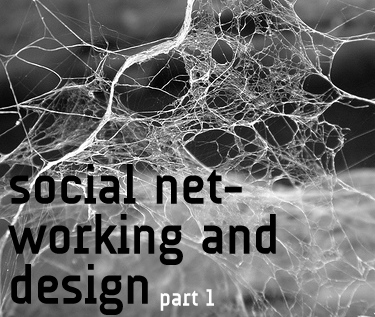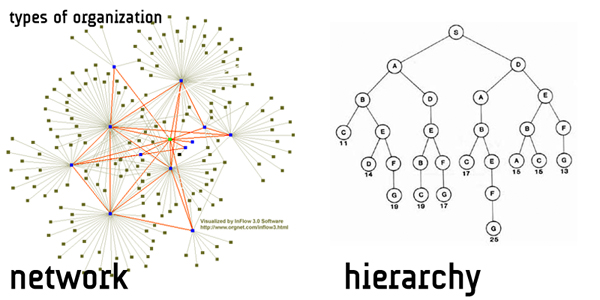Social Networking and Design part 1

The past decade has seen the rise of the network paradigm in the understanding of many facets of our society, from online communities to scientific analysis. The idea of networks serves both as a model with which to view the world and an organizational principle. I was first introduced to subject by Waldrop’s Complexity which covers some of the early scientific work defining the field and focuses on networks and dynamic systems. The scientific community was the first to realize the importance of networks as they proved a constructive way to view many phenomena. Communication networks, biological pathways, the spread of disease, and economics are just a few examples of fields whose study has greatly benefited being viewed as networks. Studying these systems, scientists introduced the principle of network organization, which is not based on a hierarchy of control but on mutual connections between entities. Thus it is described as “horizontal” and “self-organizing”.

The business world followed science’s lead adopting networks and complexity as a new business principle. Terms like self-organizing and horizontal structure quickly became buzz words. Some businesses are considering replacing rigid chains of command with models that allow independence and natural synergy to encourage innovation. In such systems, individuals have more freedom and can better use their creative energy as a productive force.
Activists and political thinkers also are starting to use the paradigm of networks. Hardt and Negri’s Empire describes a world dominated not by a single hegemony, but by a network of powers, and thus advocates the need for a networked resistance to that power. Old models of political organizing through unions and political parties are fading and being replaced new forms of organizing advocated by a younger generation. In many cases it appears as a network of individuals normally independent but able to quickly form into a large force for direct action. One example of this organization is the street medics of the activist community. These are a group of people who provide medical assistance during large protests. They have no formal structure outside of these large events, but quickly form a very organized group which provides medical help to thousands of people in crisis situation. This group was also one of the first to provided assistance to New Orleans after Katrina before national agencies were able to respond.
And finally, we see the emergence of artificial social networks such as MySpace and Facebook that have become important parts of our generation’s social lives.
But what does any of this have to do with design and craft? In all of these examples, there is a sense of the importance of networks and the desire to use these networks productively. People think networks are a powerful thing, whether its in business, politics or science; however, it is difficult to find a conscious effort to create a network structure that has been successful. Unsurprisingly, most businesses remain largely hierarchical. Corporations are generally not based off of voluntary work (by choice but not free), so they require a hierarchy of bosses and managers telling those below what to do. These kind of coercive relationships are harder to maintain in a network structure. Despite some successes, the activist community has still not become organized regardless of the method used. And as we all know, Facebook and MySpace do not serve any productive purpose what-so-ever.
But independent design is emerging as the first area to employ networks to its own advantage. In the last few years, social networking sites that cater to independent designers like Etsy and Stylehive have flourished. Design blogs have also taken a prominent role in the promotion of up and coming designers. These trends are a sign that the design market is turning away from a hierarchical structure based in galleries, shows, magazines, and museums. Instead there is a network of websites and blogs that serve to promote and market designers.
Because consumers can find producers without the aid of intermediate institution, designers can sell directly and be independent in a way that was formerly impossible. During my childhood, my parents were involved in the craft community. They made most of their sales by traveling to craft shows. But there is only a select community which goes to those kind of shows; it is very isolated. The ability to sell without an intermediary has allowed the growth of a new type of craft community. Since designs do not have to be approved by some entity which has its own taste and image, quirky handicrafts are one of the biggest benefactors of this new system. They seem to comprise the majority of sellers on Etsy and are often featured in giant blogs like BoingBoing.
Of course, we are still only seeing the beginnings of a change in the design market, and there are many questions. How will this progress? Do we see the weakening of old institutions like galleries, craft shows, museums, etc? Why is design one of the first areas to adopt the model with success? Can other areas, commercial or otherwise, learn from this experience for instance: science, education, and small manufacturing? And there are many more things we can ask about how this system does and/or should work. These are questions to think on and perhaps write on later.


